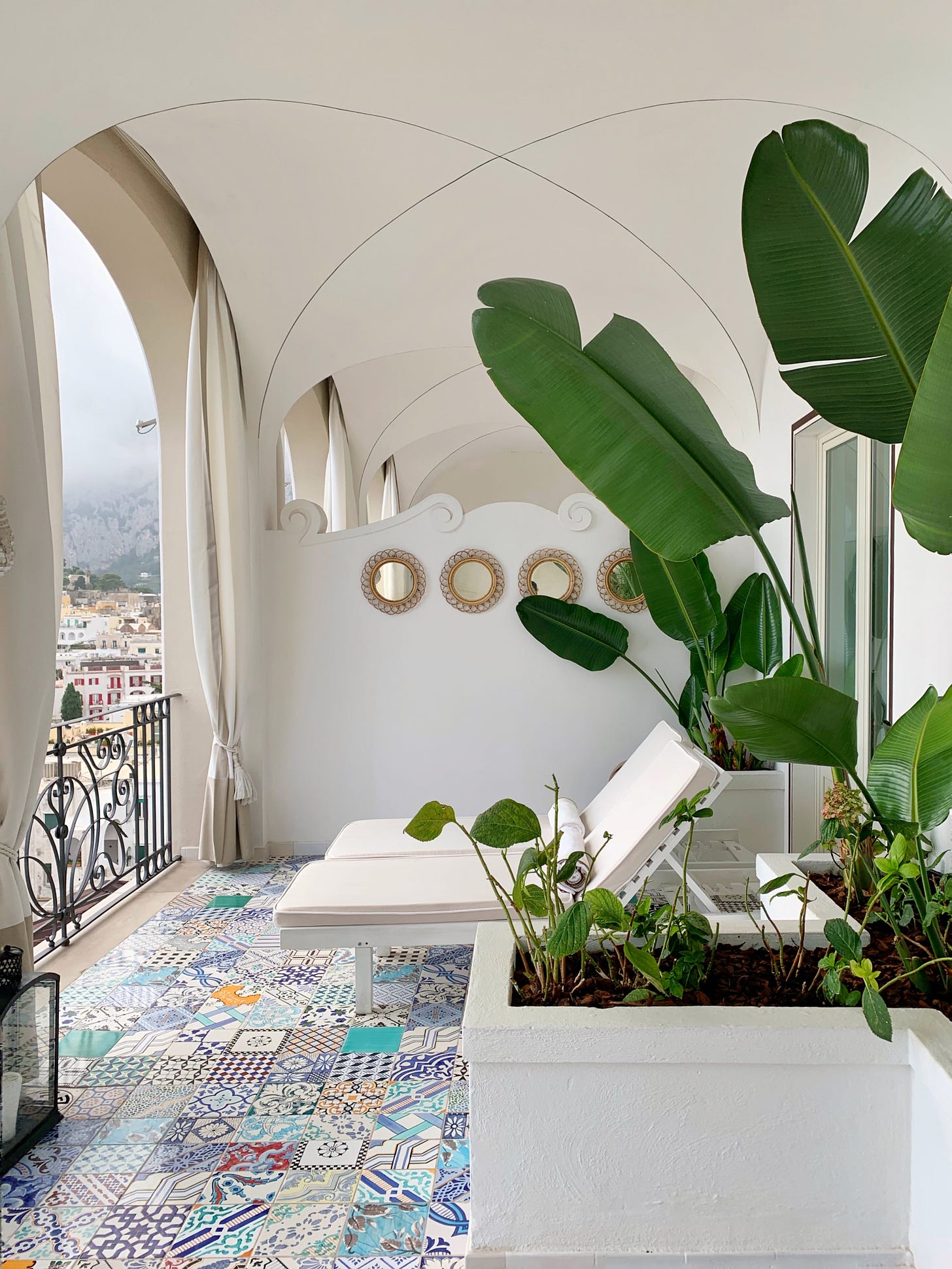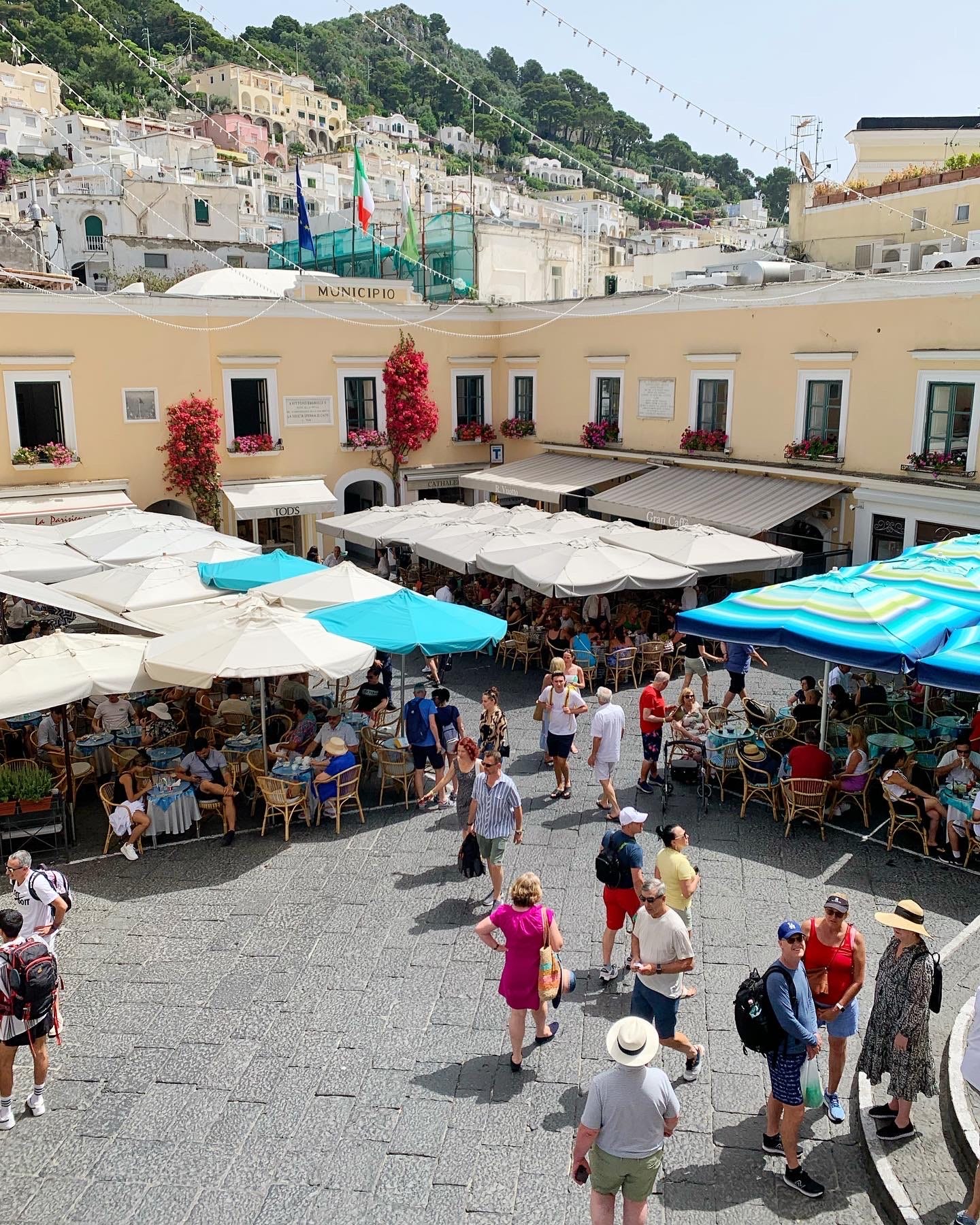Welcome to the New Roman Times’ 72 Hours series! Why 72 hours? Because the New York Times publishes a “36 Hours” series, but in my opinion, 36 hours isn’t nearly enough time to spend in Italy’s greatest cities and most compelling regions. From time to time, I’ll spotlight popular destinations like Milan, Florence, Venice, and the Amalfi Coast for paid subscribers. Have a place you’d like a 72 hours guide to? Email me or leave a comment here!
Rising dramatically from the Bay of Naples, Capri needs little introduction. Italy’s most glamorous island, it became a symbol of la dolce vita in the 1950s and ‘60s, but it’s been steeped in myths for 2,000 years. Everyone who’s anyone has vacationed in Capri, from Jennifer Lopez to Jackie O., and long before them the Roman emperors Augustus and Tiberius, who ruled the empire from his villa there for more than a decade.
The island is also a bit of a victim of its own success. It’s one of the most expensive places in Italy and, during the height of the summer season, one of the most crowded. When I was there on assignment in June, I paid three times as much for an espresso standing at the bar of a café on the Piazzetta (the main square) as I would have just about anywhere else in Italy. When Marco and I took the funicular down to the port to catch the ferry home, there were hordes of people waiting in the heat to ascend, and just navigating from our hotel to the funicular a few minutes away through the crowds was a bit unpleasant.
If it seems like I’m discouraging you from going to Capri, that’s not my intention. But I do think it’s important to set up realistic expectations. Is Capri one of the most gorgeous places in Italy, full of beauty at every turn? Yes. Is it overpriced and overcrowded? Also yes. Knowing that, would I genuinely recommend you go there? I would, but I think you have to be a bit strategic in order to really enjoy it to the fullest. So I’ve put together a guide to how to spend 72 hours on the island, with tips for doing just that.
DAY ONE
With an area of four square miles, Capri is small but not tiny. There are only two towns: Capri (yes, the same name as the island) and Anacapri. In one day, you can cover a lot of ground, but I recommend staying for a couple of nights so you can see more and do it at a more relaxed pace—after all, that’s what la dolce vita is all about.
3 p.m. - Arrive in Capri and check into your hotel
There are a handful of companies that run ferries and hydrofoils to Capri. I’ve always taken a hydrofoil from Napoli Beverello, which takes just under an hour and costs around €25 per person for each leg of the trip. You could, however, get to Capri from Amalfi, Positano, or other ports on the Amalfi Coast.
Use this website to check the schedules and book your trip, but remember that you need to arrive at the port at least 15 minutes before the scheduled departure time and check in at the ticket window of the company you booked with in order to get an actual boarding pass (usually just a stub of paper) and board the boat.
When you arrive at the Marina Grande, your hotel may or may not send someone to accompany you and help with your luggage. (The five-star luxury hotels usually do.) If not, the cheapest way to get from the port to the main part of town is via funicular. There might be a wait, but once you get on it’s a quick ascent to the Piazzetta.
On my trip to Capri in June, while on assignment for Travel + Leisure, I was lucky enough to stay at Hotel La Palma, the buzzy new five-star hotel by the Oetker Collection, and Il Capri Hotel, a new boutique hotel in a pink neo-gothic building.
On a previous trip, I stayed at the Capri Tiberio Palace and loved it. I have also stopped by other top hotels, including J.K. Place Capri, Capri Palace (before it was taken over by Jumeirah), and Quisisana, where rates can easily exceed €1,000 per night. But a casual search on Booking.com shows that there are modest B&Bs and hotels with rates from around €200 to €350 per night.
5 p.m. - Passeggiata
After resting a bit in your room or by the pool, freshen up and head toward the Piazzetta for an evening stroll. By around 5 p.m., most of the day trippers will have left and the beach-goers will just be starting to return, making it the ideal time of day to explore. The aforementioned Piazzetta is Capri’s most lively square and the narrow pedestrian streets branching off from it are lined with boutiques and restaurants.
You could do some window shopping at the designer boutiques lining Via Camerelle or walk along Via Tragara until you reach the belvedere with stunning views of the Faraglioni, the three enormous sea stacks that appear on postcards of Capri. If you’re after sandals, Canfora on Via Camerelle is the iconic shop where Jackie O. used to have her sandals made.
Aside from the designer boutiques, I recommend popping into Carthusia for perfumes (they have several shops on the island, including one with a laboratory in the back) and Eco Capri, a concept shop that sells chic caftans, beachwear, and home decor featuring drawings by the owner’s grandmother reinterpreted in a modern way.
Another lovely place to visit is the Giardini di Augusto, beautiful gardens with statues, hand-painted tile benches, and incredible views of the sea and the Via Krupp below. A ticket costs just a few euros, making this not only one of the most beautiful places on the island but also one of the most affordable.
Keep reading with a 7-day free trial
Subscribe to The New Roman Times to keep reading this post and get 7 days of free access to the full post archives.







